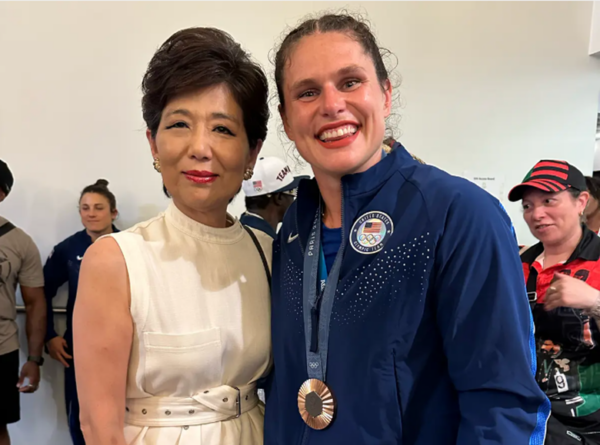
Philanthropist Michelle Kang (left) and rugby star Ilona Maher. Photo courtesy of Ilona Maher.
An Olympic bronze, a $4 million donation and a star player-turned-celebrity are lifting the prospects of women’s rugby across the country from a perch in Colorado.
Glendale-based USA Rugby wooed women’s pro soccer team owner Michele Kang at the Paris Games in July, inviting her to watch her first rugby match — one where Team USA landed its first medal at this year’s Games.
Making the pitch was USA Rugby board member Steve Argeris, who had represented Kang in building her women’s pro soccer organization (with teams in Washington, DC, London and Lyon, France). Argeris, a dealmaker at the law firm of Hogan Lovells, represented the Walton-Penner family when it bought the Broncos for $4.65 billion in 2022, then the highest paid for a professional sports team.
The $1 million-per-year pledge from Kang, who also owns a share of the Baltimore Orioles, will help the U.S. women’s team train full time for the 2028 Olympic podium. U.S. women fare better internationally than the men, who compete against nations where rugby is the dominant sport: Ireland, New Zealand, South Africa and Wales. But without pay, many “pro” women train only two days per week while working day jobs.
Kang has put up $50 million to seed research into female athletic performance “so we can stop training women as if they are simply small men.” She also offered the women’s rugby team her global experts from her organization, Kynisca, named for the first female champion in the Olympics.
Bill Goren, who became CEO of USA Rugby in February, called the gift “transformative” for women’s rugby. It could also enable a greater focus on women at the 15-person federation, which reported revenue of $16 million in 2023. That year, it spent more than twice as much on men’s coaching as on women’s.
The federation directs the Olympic team and national men’s and women’s teams that compete internationally, and an 11-team male pro league, Major League Rugby, as well as college, youth and high school leagues.
In the USA Rugby announcement, Kang is pictured alongside Ilona Maher, whose sassy social media posts promoted her team’s games at the 2021 Tokyo Games, when COVID-19 restrictions kept stadiums empty. Maher, who helped Quinnipiac University in Connecticut to three national championships, also created a platform for herself to garner sponsorships from Google, Maybelline and Secret. Her TikToks showing life in the Olympic Village went viral when Maher compared dating opportunities in the Olympic “Villa,” with its cardboard beds, to Love Island.
The 200-pound, 5-foot-10 athlete said rugby is empowering for women, with distinct roles for all sizes of frames. In September, Maher showed off shoulder muscles at the Emmy awards, on “Late Night with Seth Meyers” and on “Dancing with the Stars,” where she and her much smaller partner flipped one another. In September’s Sports Illustrated Digital’s swimsuit edition, she kissed the bronze medal under her tagline: “Beast. Beauty. Brains.”
With more than 6 million followers on social media, she has drawn major attention to the sport, particularly from that of girls and women. “Ilona has made potentially the biggest impact on rugby we’ve seen in a generation, on and off the pitch,” USA Rugby’s Goren said.
The publicity around the Olympic win is attracting more young women to give rugby a try. The mostly male Colorado School of Mines in Golden now has a roster of 54 for its Division III women’s club team, up from 32 last year, according to women’s head coach Dan Roder. The U.S. didn’t have a single full-time college coach until Vassar College hired one in 1995. College teams are split among three leagues.
USA Rugby will need to harness the current buzz to find new sponsorships and broadcast deals to fund a bigger pipeline to the top. These are hard to come by when companies sign deals with individuals rather than teams. So far, it’s up to women such as Maher to create their own stage.
“The traditional role for women is to light the fire, but the community has to throw gas on it,” said Becky Carlson, Quinnipiac’s head coach of women’s rugby. “If the organization that represents the sport doesn’t invent a structure, then it’s a candle in the wind.”

